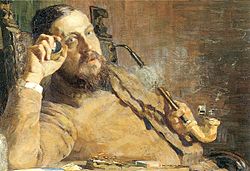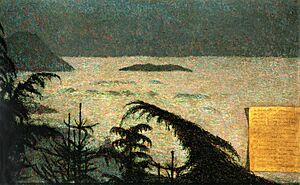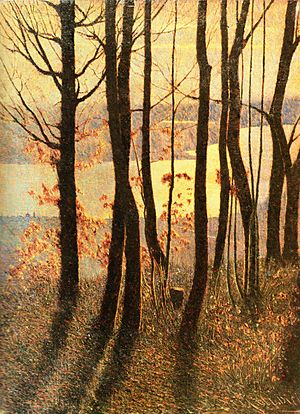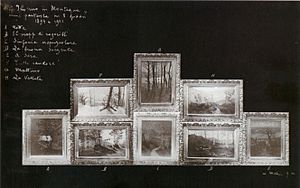Vittore Grubicy de Dragon facts for kids
Quick facts for kids
Vittore Grubicy de Dragon
|
|
|---|---|

Portrait of Vittore Grubicy by Giovanni Segantini
|
|
| Born | 15 October 1851 |
| Died | 4 August 1920 (aged 68) |
| Nationality | Italian |
|
Notable work
|
Winter in the Mountains |
| Movement | Divisionism |
Vittore Grubicy de Dragon (born October 15, 1851 – died August 4, 1920) was an Italian painter, art critic, and art gallery owner. He helped bring a new painting style called Divisionism to Italy. Divisionism used small dots or strokes of pure color to create a vibrant effect. His ideas and artwork inspired many Italian painters in the late 1800s. His art gallery also helped new artists show their work.
Contents
Vittore Grubicy's Life
Vittore Grubicy grew up in a wealthy family in Milan, Italy. His parents loved art, so he learned about art and met artists from a young age. He visited art scenes in Milan and other European cities.
Starting an Art Gallery
After his father passed away in 1870, Grubicy joined a group of artists, poets, and writers in Milan. They were called the Scapigliatura. This group wanted to mix art with everyday life. Vittore loved this new way of thinking.
He convinced his brother, Alberto, to buy an art gallery with him. It was named the Galleria Fratelli Grubicy. Alberto managed the money side of the gallery. Vittore traveled around Europe to find the newest art trends.
At first, their gallery showed art from Scapigliatura artists like Tranquillo Cremona. But soon, they started showing newer Italian artists. These included Giovanni Segantini, Emilio Longoni, and Angelo Morbelli.
Discovering Divisionism
Between 1882 and 1885, Grubicy spent a lot of time in the Netherlands. There, he became friends with artists from the Hague School, especially Anton Mauve. Mauve greatly influenced Grubicy's art and how he thought about art.
When Vittore returned to Italy, he encouraged the artists he worked with to paint like Mauve. He also suggested they look at the style of Mauve's cousin-in-law, Vincent van Gogh. Painter Emilio Longoni once wrote that Vittore Grubicy brought Divisionism to Italy. He said Grubicy made artists like Segantini and Morbelli try it.
Grubicy was so passionate about Divisionism that he convinced Segantini to repaint an artwork. The painting, Ave Maria by the Lake, was already finished. But Segantini reworked it using the Divisionist technique.
Art Critic and Promoter
In 1886, Grubicy became an art critic for the newspaper La Riforma. For the next four years, he used his writing to share his art ideas. He wrote a lot about how light helps artists show emotions in their paintings. He shared these ideas in La Riforma and Cronaca d'Arte, a very important Italian art magazine.
In 1889, Vittore left the gallery business. He had disagreements with his brother. After that, he spent most of his time painting his own art and writing about other artists. He still looked for new talent.
In 1891, he helped organize the first big show of Italian Divisionist paintings. It was held at Milan's Brera Tiennale. Some art critics wrote very harsh reviews of the paintings. But Grubicy wrote positive reviews in several newspapers.
One important painting at that show was Maternity by Gaetano Previati. When Grubicy wrote about this work, he introduced the idea of Symbolism in Italian painting. He praised the painting as a new kind of art he called "mystico-ideist."
Creating Winter in the Mountains
Grubicy also influenced artists by creating artworks made of many paintings. These were arranged together as triptychs (three panels) or polyptychs (many panels).
In the early 1890s, he started planning a polyptych with sixteen panels. He called it Winter in Miazzina. This artwork was a series of paintings that could be changed around. They showed his feelings during the long winters he spent in Miazzina, near Lake Maggiore.
Grubicy kept changing each painting over many years. He changed them based on his mood and what he was interested in. Finally, in 1911, the polyptych took its final shape. It had only eight paintings and was called Winter in the Mountains.
Even with all his hard work, he did not show this artwork during his lifetime. It was first shown together at the Rome Biennale in 1921, the year after he died. After that, the paintings were separated and sold to different collectors and museums.
Grubicy took a photograph of the polyptych as he wanted it to be seen. Because of this photo, the artwork has been put back together for several shows since his death. One of the most recent was at the Kunsthaus Zürich in 2009.
Later Years
Grubicy's health got worse after 1910. During the last ten years of his life, he had to stop painting completely. However, he continued to help new artists. He especially promoted Carlo Carrà, Pietro Angelini, and Arturo Tosi.
Vittore Grubicy died at his home in Milan in 1920.
See also
 In Spanish: Vittore Grubicy de Dragon para niños
In Spanish: Vittore Grubicy de Dragon para niños




